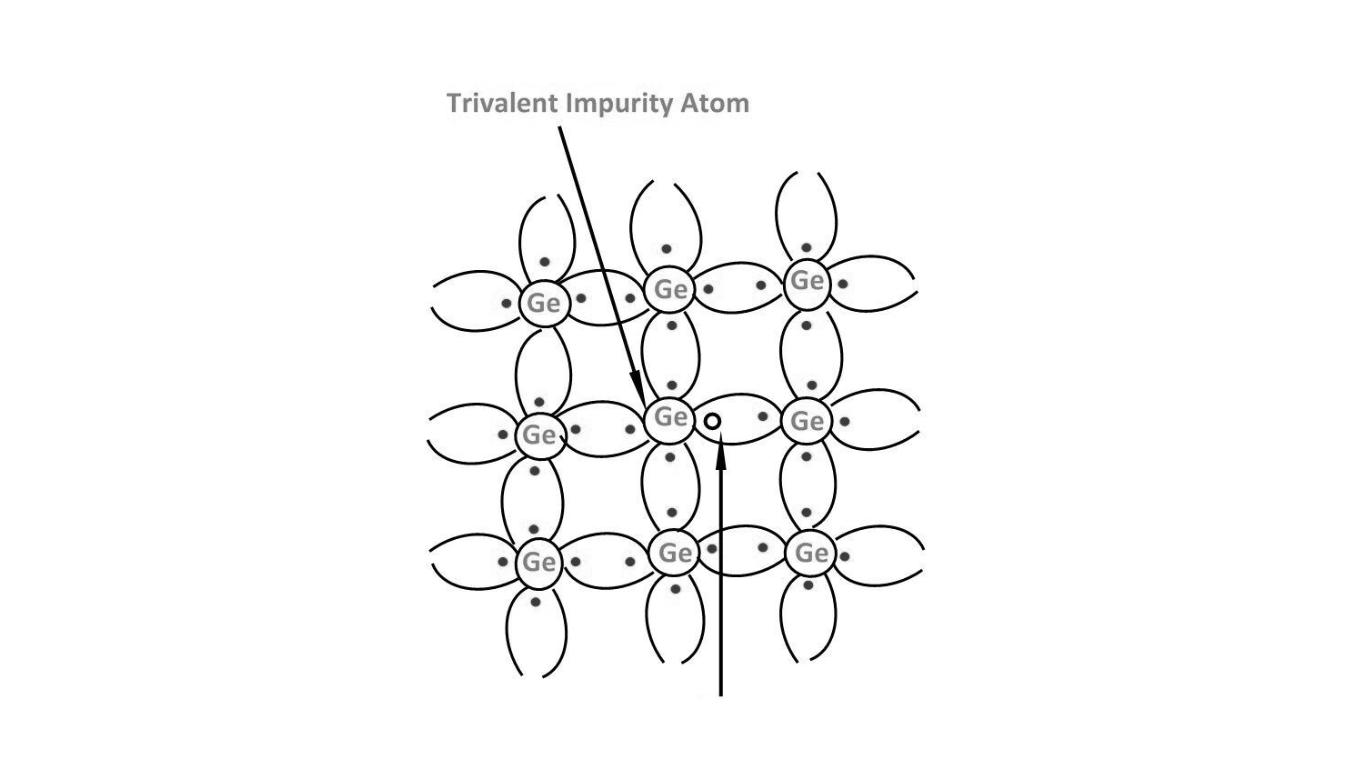What is p type semiconductor (Basic Details)
When you add a small amount of trivalent impurity, such as gallium or indium, to a pure semiconductor, you create an extrinsic p-type semiconductor. This process generates a large number of holes in the material. These impurities are called “Acceptor Impurities” because each atom creates one hole, which can accept an electron.
The p−type semiconductor is formed when the Trivalent impurity is added to the pure semiconductor.

In the case of a trivalent impurity like gallium added to a germanium crystal, each gallium atom fits into the crystal structure in such a way that its three valence electrons form covalent bonds with three surrounding germanium atoms. However, the fourth covalent bond remains incomplete, with one electron short. This missing electron is called a Hole. As a tiny amount of Gallium impurity contains a large number of atoms, it provides millions of holes in the semiconductor.
Conduction Through p-Type Semiconductor
When a potential difference is applied across a p-type semiconductor, the holes in the valence band move towards the negative terminal, resulting in positive or p-type conductivity. The conductivity of an n-type semiconductor is higher than that of a p-type semiconductor because the electrons in the conduction band of the n-type semiconductor are more mobile than the holes in the valence band of the p-type semiconductor.
![]()
Energy Band Diagram of p-Type Semiconductor
The energy band diagram of a p-type semiconductor shows a large number of holes or vacant spaces in the covalent bond, created by the trivalent impurity. Additionally, a small quantity of free electrons is available in the conduction band, generated by thermal energy at room temperature forming electron-hole pairs. However, the number of holes predominates over electrons in the conduction band, giving the material its name as a p-type semiconductor, where “p” stands for positive material.
Why is it called a P-type semiconductor?
A p-type semiconductor is a type of extrinsic semiconductor that has been treated with electron acceptor atoms. These acceptor atoms create positive holes in the crystal, making them the majority of charge carriers in the material. That’s why we called a P-type semiconductor
What are p-type semiconductors Give an example.
Some p-type semiconductor examples are- boron-doped silicon, aluminum-doped silicon,boron-doped Germanium, etc.
Why is p-type positive?
In a semiconductor, when an acceptor gives away extra positive charges known as “holes,” it becomes a p-type semiconductor. The “p” in p-type stands for positive, indicating the prevalence of positive charges in the material.
Advantages of the p-type semiconductor
Easy Current Flow: P-type semiconductors have special positively charged holes that allow an electric current to move easily through them.
Digital Electronics: P-type semiconductors are important in making complementary circuits (CMOS) with N-type semiconductors. These circuits are widely used in digital devices because they consume less power and are less affected by noise.
Precise Control: P-type semiconductors help in controlling the flow of electric current in electronic devices. By using a voltage at the gate terminal of a field-effect transistor (FET), the flow of holes can be regulated, enabling functions like amplification and switching.
Application of p-type semiconductor
Transistors: P-type semiconductors are used in making PNP transistors. These transistors are commonly found in amplifiers, voltage regulators, and switches.
Integrated Circuits: P-type semiconductors play an important role in CMOS technology. They work together with N-type semiconductors to create complex digital circuits used in microprocessors, memory chips, and logic gates.
Diodes: P-type semiconductors are used to make P-N junction diodes. These diodes are used in rectifiers, signal demodulation, and voltage regulation.
Solar Cells: P-type semiconductors are used in solar cell technology. When combined with N-type semiconductors, they create a P-N junction that converts sunlight into electricity.
Thermoelectric Devices: P-type semiconductors are used in thermoelectric devices that generate electricity from temperature differences. When paired with N-type semiconductors, they form thermocouples used in temperature sensors and power generation.